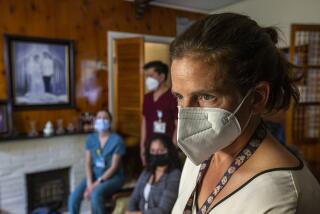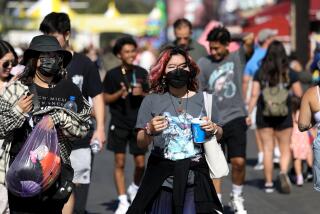California coronavirus spikes worsen over holiday weekend
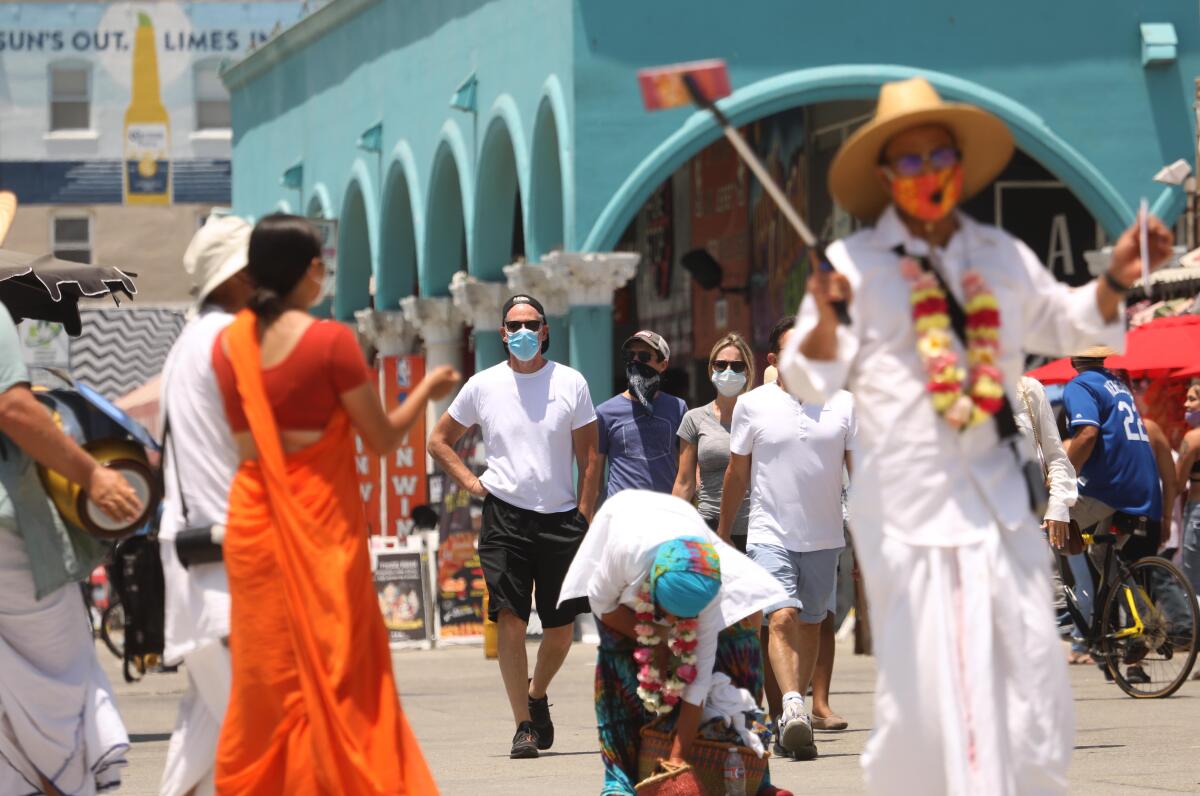
The California coronavirus outlook worsened over the holiday weekend, as hospitalizations continued to rise and more counties were added Sunday to Gov. Gavin Newsomâs COVID-19 watch list, which is now at its highest level since the pandemic began.
The rate at which coronavirus tests in California are coming back positive has jumped 42% over the last two weeks, according to data published on the Los Angeles Timesâ California coronavirus tracker. An increasing rate of positive test results is an indication that disease transmission is worsening.
The Fourth of July marked the 15th consecutive day that California tallied record hospitalization numbers of confirmed coronavirus patients. On Saturday, the state recorded 5,669 patients with confirmed coronavirus infections in California hospitalsâan increase of 62% over the previous two weeks.
On June 27, just a week earlier, the state had reported 4,498 hospitalized patients with confirmed cases of COVID-19. On June 20, the number was 3,494.
The number of intensive care unit patients statewide with confirmed coronavirus infections is up 63% over the last three weeks. On Saturday, there were 1,711 people with confirmed coronavirus infections in the ICU; on the previous Saturday, there were 1,376; the week before that, there were 1,149; and on June 13, there were 1,049.
And Los Angeles County officials said Sunday that the holiday weekend saw the highest single-day count of new cases since the pandemic began. More than 3,200 new cases were reported in the county on Friday.
Contra Costa County, in the San Francisco Bay Area, and rural Colusa County, northwest of Sacramento, were added Sunday to the list of regions being monitored for their rising case counts and increasing hospitalizations, bringing the number to 24. Marin, Monterey and San Diego counties joined the list Thursday.
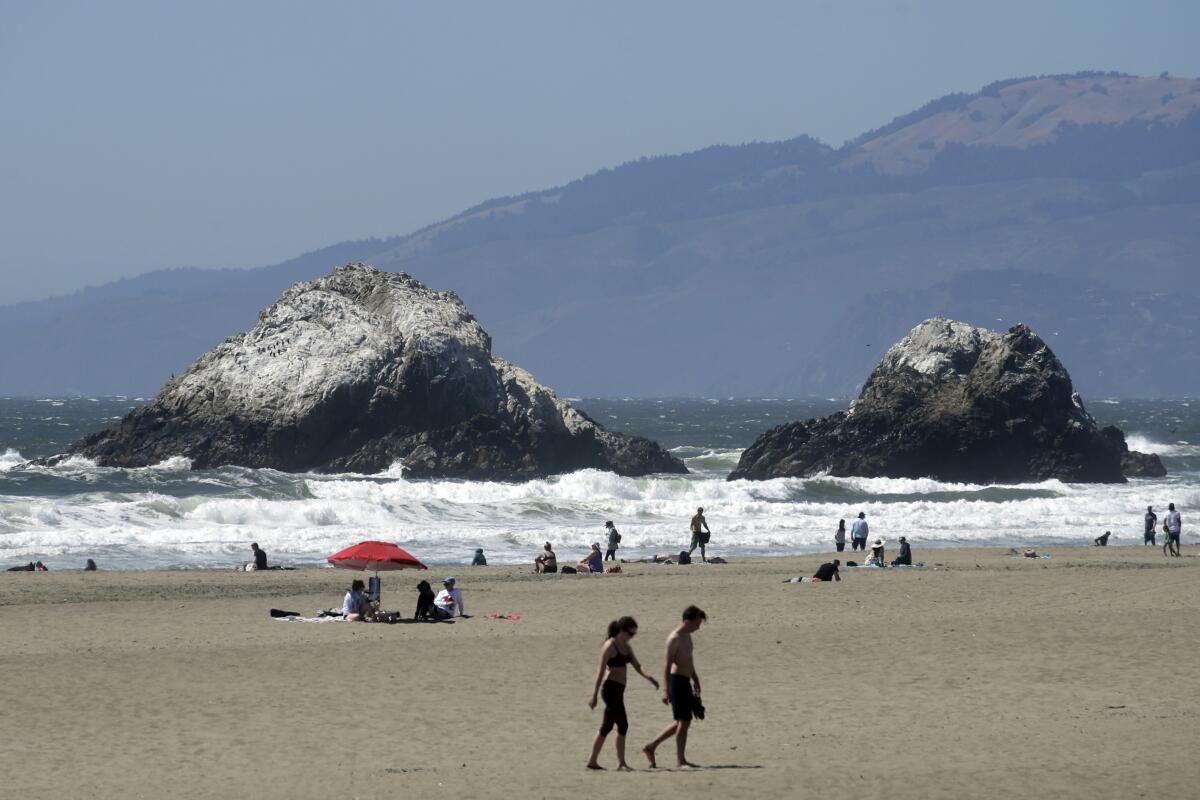
In many areas, the jump in cases is attributed to more people leaving home to go to work or seek services and a rise in family and community gatherings â hallmarks of summer and an increasing restlessness as the pandemic drags on. Marin County, according to the state, has an additional problem; an outbreak raging in San Quentin State Prison has infected nearly a third of the inmates.
On Sunday, Marin County officials announced that indoor restaurant dining rooms would again be required to shut their doors, bringing an end to a short window of sit-down service and hold-in-your-hand menus. Restaurant dining rooms in the area had only been open for a week since the statewide shelter-in-place order was established in mid-March. The current ban will last for at least 21 days.
Nationwide, the picture is also grim. The former commissioner of the U.S. Food and Drug Administration said on CBSâs âFace the Nationâ Sunday that âweâre right back where we were at the peak of the epidemic during the New York outbreak.â
But Dr. Scott Gottlieb, who served for two years during the Trump administration, said thereâs a big difference now: âWe really had one epicenter of spread when New York was going through its hardship. Now we really have four major epicenters of spread: Los Angeles, cities in Texas, cities in Florida, and Arizona.â
Gottlieb also added that itâs possible the nation could run short on the supply of remdesivir, a key drug used for the sickest COVID-19 patients.
âThat drug has a long manufacturing cycle,â he said. âWeâre unlikely to be able to ramp up supply between now and the end of the year.â
And he warned that there is no relief in sight, that autumn will be a âhardâ one, that âitâs not clear that itâs going to get better.â
âWeâre going to have epidemics that come and go across the nation in different cities,â Gottlieb said. âTheyâll light up at different times. But weâre not going to really be able to crush this virus at this point because thereâs just so much infection around.â
Southern California is a case in point.
Hospitalizations of patients with confirmed coronavirus infections in Los Angeles County have jumped nearly 50% in the last three weeks. On Saturday, there were 1,921 patients in L.A. County hospitals with confirmed coronavirus infections; seven days earlier, there were 1,710; the week before that, there were 1,453; and the week prior to that, there were 1,285.
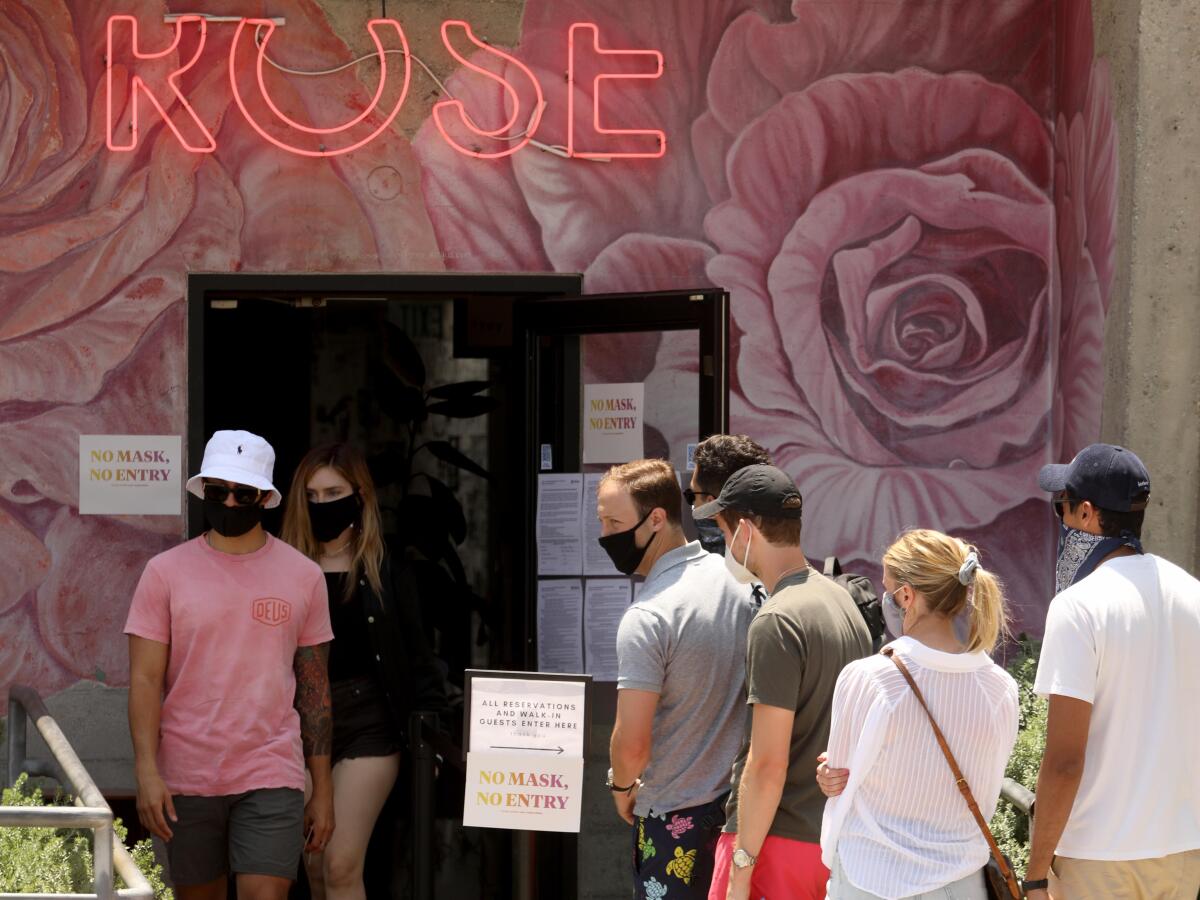
Just days before the holiday weekend began, L.A. County officials warned about âalarming increases in cases, positivity rates and hospitalizationâ and projected the possibility of running out of hospital beds in two to three weeks; the number of ICU beds could be exhausted sometime in July.
In a memo issued Saturday to local healthcare providers, the L.A. County Department of Public Health warned that, âif the trajectory continues, the number of ICU beds â our most limited resource â is likely to become inadequate in the near future.â
In an update July 1 on the San Bernardino County website, officials said the county reported 753 new cases on June 30, âthe highest number of cases reported on a single day.â On the Fourth of July, the county tallied 1,024 new cases. COVID-19-related hospitalizations and use of ICU beds, the county said, have âseen a steady increase since June 17.â
In Orange County, COVID-19 hospitalizations are up 72% in the last two weeks. On Saturday, there were 624 people hospitalized in Orange County with confirmed coronavirus infections; on the previous Saturday, 492 were hospitalized; and on the Saturday before that 363 were in the hospital.
Coronavirus hospitalizations in Ventura County rose 74% in the last two weeks. On Saturday, 82 people were in the hospital with confirmed coronavirus infections; the previous Saturday, there was 65, and the Saturday before that, there were 47.
Riverside County has reported a 63% rise in confirmed COVID-19 cases over the past three weeks, according to the Los Angeles Times coronavirus tracker: 485 new cases on July 4; 340 on June 27; 297 on June 20.
Brooke Federico, public information officer for Riverside County, said Sunday that the regionâs licensed intensive care units are 97.4% full, âa high number.â But only 71% of the countyâs licensed hospital beds are currently in use, she said, and only 13% of those beds have confirmed COVID-19 patients in them.
âOur hospitals do have surge capacity to treat people at the facilities above and beyond the licensed capacity,â she said. âThatâs what weâve been preparing for.â
Imperial County â where thereâs a serious doctor shortage and a quarter of the population lives in poverty â is a different story.
During a June 26 news briefing, Newsom singled out Imperial County as the area statewide hit hardest by the coronavirus. For every 100,000 people in the county, which borders Arizona and Mexico, more than 3,800 have been infected with the coronavirus. In the state as a whole, about 650 per 100,000 people have been infected.
The only two hospitals in Imperial County â El Centro Regional Medical Center and Pioneers Health Center in Brawley â have been overrun. In just the last five weeks, Imperial County has transferred more than 500 coronavirus patients to other counties for treatment â an average of 15 to 17 people a day, Newsom said.
Some of the overflow has been attributed to an unusually high number of hospital admissions linked to cross-border traffic from Mexicali. Newsom said the state is âworking with Customs and Border [Protection] because of issuesâ relating to the border in Mexicali and Calexico.
Hospitals do not disclose where their patients come from, but they do routinely treat cross-border travelers, said Karina Lopez, public affairs liaison at Pioneers Health Center. Imperial Countyâs population is 85% Latino, and many residents are migrant farmers or recent immigrants.
When determining which patients to care for, Lopez said, Pioneers Health Center does not consider a patientâs residence. But while the hospital has filled only 68 of its 107 acute care beds, it has turned some patients away.
âThe main concern for us was that we do not have enough acute care nurses to care for the patients coming in,â Lopez said. âWhile we do have beds for them, and we do have space for them, we donât have enough staff.â
More to Read
Sign up for Essential California
The most important California stories and recommendations in your inbox every morning.
You may occasionally receive promotional content from the Los Angeles Times.

